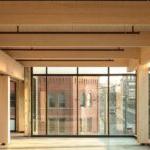解决方案文件
Differential Material Movement in Tall Mass Timber Structures
Covers reasons for vertical movement, methods of calculating anticipated movement, calculated vs. on-site verified movement, detailing options, and strategies implemented on North American projects.
As the height of mass timber buildings continues to grow, a new set of design and detailing challenges arises, creating the need for new engineering solutions to achieve optimal building construction and performance. One necessary detailing consideration is vertical movement, which includes column shrinkage, 共同解决, 和蠕变. The main concerns are the impact of deformations on vertical mechanical systems, 外部附件, 内部分区, as well as differential vertical movement of timber framing systems relative to other building features such as concrete core walls and exterior façades.

It is a common narrative that tall mass timber buildings are relatively new to the U.S., and wood structures between seven and 24 stories have been built successfully in other countries for more than a decade. 然而, while there are dozens of timber buildings over eight stories tall worldwide, the suggestion that America is new to these types of projects is fast becoming out of date.
U.S. interest in tall timber buildings, i.e., buildings that exceed height and area limits for wood construction prescribed in the 2018 and previous versions of the International Building Code (IBC), has steadily increased over the past several years. With the introduction of three new construction types in the 2021 IBC—Types IV-A, IV-B和IV-C, 哪一个最多允许18人, 12 and nine stories of mass timber construction respectively—these projects are also getting built. 目前, about 10% of the mass timber buildings in design or built in this country exceed the 2018 prescriptive height limits. 仅2021年一年, tall projects such as INTRO in Cleveland, 密尔沃基的崛起, 莱诺克斯在波士顿, 80M在华盛顿特区, and Apex Plaza in Charlottesville, VA either started or completed the mass timber portion of construction. At the time of writing, several others are set to break ground.
This paper analyzes the reasons for vertical movement (both short and long term), provides methods of calculating anticipated movement, compares calculated movement to on-site verified movement, highlights detailing options, and discusses vertical movement strategies implemented on tall mass timber projects completed in North America.



